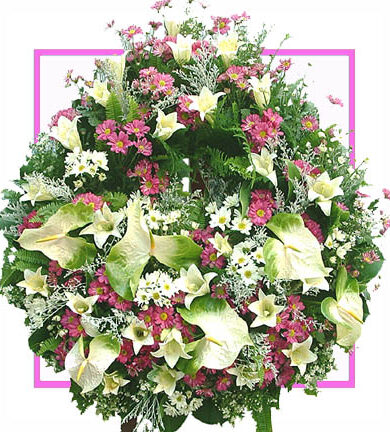Guwahati, formerly Pragjyotishpura meaning “city of eastern light,”, “city of eastern astrology”, and Durjaya meaning “impregnable” were the capitals of the ancient state of Kamarupa under Varman’s and Pala’s respectively. Many ancient Hindu temples are in the city, Kamakhya, Umananda, Navagraha, Sukreswar, Basistha, Lankeshwar, Doul Govinda, Dirgheshwari, Ugro Tara, Rudreswar etc. are but a few so also known as the “The City of Temples.” Dispur, the capital of the Indian state of Assam is in the city and is the seat of the Government of Assam. |
Guwahati War Cemetery: A World War II war cemetery, maintained by the Commonwealth War Graves Commission This is the one cemetery among the nine cemeteries in India which has war graves of Japanese soldiers. The cemetery has 521 graves, including 316 known and 18 unknown graves of soldiers from the United Kingdom, 136 known and seven unknown Indian soldiers, four from Canada, four from South Africa, one from New Zealand, two graves of soldiers whose nationality is unknown, 11 graves of Japanese soldiers and 24 graves of Chinese Army soldiers. |
The city is having notable changes in its morphology with rapid expansion. The Khanapara road is being converted into four lanes and it will be extended up to a Changsari in the near future. Projects are undertaken on the outskirts like the water park in Rani, which has brought those far-flung areas under city reach by visit by tourists. The road towards Airport from Jalukbari is also being converted into a four-lane road. Two five star hotels are on the verge of being set up, raising hopes that by a decade or so, the city will be twice its size now. |
During medieval times between the 12th and 15th centuries AD, after the destruction of the Kamata kingdom, the city lost its earlier glory and became mainly a strategic outpost of the Koch Hajo and Ahom kingdom. When the western part of the Koch Kingdom (Koch Bihar) fell to the Mughals, the eastern half (Koch Hajo) eventually became a protectorate of Ahom. Although the border between the powers (Ahoms and Mughals) fluctuated between the Kartoya river (now in North Bengal) to the Manas and Barnadi rivers, Guwahati remained an important outpost. |
The gross domestic product of Guwahati metro was estimated at $1 billion in 2010. As a river port, Guwahati has traditionally been an important administrative and trading center. Separate income estimates are not yet available as city-level income estimation is not a traditional practice in India, and is not practiced in a systematic and continual manner. However, by looking at the agglomeration of activities and employment patterns it can be easily understandable that the city contributes a lion’s share of the state’s income. |
The most important corridor is along the Guwahati-Shillong (GS) Road towards the south (almost 15 km from the city-center). The GS Road is an important commercial area with retail, wholesale and offices developed along the main road; it is a densely built residential area in the inner parts. The capital complex of Assam at Dispur is in this corridor. This corridor has facilitated the growth of a southern city sub-center at Ganeshguri, along with other residential areas to the south developed during the past few decades. |
Guwahati Municipal Corporation (GMC) is the local body responsible for governing, developing and managing the city. (GMC) is further divided into 60 municipal wards. Guwahati Metropolitan Development Authority (GMDA) is an agency responsible for planning and development of the greater Guwahati Metropolitan Area, which is revising the Guwahati Master Plan and Building Bylaws. Guwahati Development Department, a special department of the Government of Assam, has been recently formed for Guwahati’s overall development. |
Fancy Bazaar: (Pron: ‘fænsi b??z?:) In the western part of the city-center is a busy commercial district for wholesale and retail. Originally called Fansi Bazaar after the district jail that executed criminals/freedom fighters by British by hanging (fansi, in the local language), the name has slowly transformed to Fancy Bazaar to denote the retail stores for clothes and garments. The place is also the hub for wholesale products ranging from food and beverages, garments, to hardware and building materials. |
The sporting infrastructures specially constructed for the 33rd National Games in 2007 include a large stadium at Sarusajai—the Indira Gandhi Athletic Stadium, the Dr. Zakir Hussain Aquatic Complex, and the Karmabir Nabin Chandra Bordoloi A.C. Indoor Hall. Other new sports structures include the Maulana Md. Tayabullah Hockey Stadium at Bhetapara, the Deshbhakta Tarun Ram Phookan Indoor Stadium at Ulubari, Rajiv Gandhi Indoor Stadium at Amingaon, Chachal Tennis Complex and Tepesia Sports Complex. |
G S Road: A long stretch of road between Ganeshguri and Paltan Bazaar, G S Road has emerged as the new commercial hub of Guwahati. G S Road boasts of some of the finest malls and restaurants Guwahati has to offer, and is considered by many to displace Fancy Bazaar and Pan Bazaar as the major shopping centers in the years to come. It is now also one of the most important and expensive pieces of property in Guwahati, containing some of the most commercially important buildings. |
Epigraphic sources place the capitals of many ancient kingdoms in Guwahati. It was the capital of the kings Narakasura and Bhagadatta according to the Mahabharata. The ancient sakti temple of Goddess Kamakhya in Nilachal hill (an important seat of Tantric and Vajrayana Buddhism), the ancient and unique astrological temple Navagraha in Chitrachal Hill, and archaeological remains in Basista and other locations support the mythological assertions of the city’s ancient past. |
Lack of sufficient road space is a major problem. The length of surfaced road within the city is presently at 218 km (ARSAC). The major corridor roads suffer from insufficient right of way, illegal construction methods, and improper planning and design. The roads in the residential neighborhoods are extremely narrow (lack of proper regulations) causing problems related to both traffic and infrastructure installations. Cul-de-sacs are neither planned nor designed properly. |
Guwahati is an important center for health facilities in eastern India, featuring many government and private specialty hospitals and health research centres. The most important are the Gauhati Medical College and Hospital, Regional Institute of Ophthalmology, Mahendra Mohan Choudhury Hospital, Dispur Hospital, Guwahati Neurological Research Centre (GNRC), Down Town Hospital, International Hospital, Dr. B. Borooah Cancer Institute, Hayat Hospital and Sankardev Netralaya. |
Navagraha Temple: Navagraha temple or temple of nine planets is situated on Chitrachal Hill to the east. It was the ancient seat of study of astronomy and astrology. The nine planets are represented by the nine linga’s inside the main temple. There is a stone imprint of solar system inside the temple.This temple just 3 km from the railway station is still a center of Astrological and Astronomical research. It was for this temple Guwahati was named Pragjyotishpura. |
Guwahati (Pron: g?w?’h?:ti) (Assamese: ???????? Guwahati (help·info)) — formerly known as Pragjyotishpura and Durjaya in ancient Assam (Kamrup) and Gauhati in the modern era — is an ancient urban area and largest city of Assam and northeastern India. It is one of the fastest developing cities in India and is a major city in Eastern India often referred as “gateway” of North Eastern Region of the country. |
River Cruise: One of the major attractions of Guwahati is the River Cruise on the Brahmaputra river. To go on a cruise on the mighty river is a thrilling experience. There are cruise vessels like ‘MV Mahabahu’, ‘Jolporee’, ‘Charaidew’, ‘MV Chandardinga’, ‘Alfresco’, ‘Baginadi’ etc. that will take visitors on joy rides on the Brahmaputra river. On board these luxurious cruise vessels tourists can relax and enjoy the beautiful view of the sunset. |
Guwahati is the major commercial and educational hub of North-East India and is home to world class institutions such as the Indian Institute of Technology Guwahati and other premier institutions like Gauhati University and Cotton College. The city is a major center for cultural activities and sports in the North Eastern region and for the administrative and political activities of Assam. The city is an important regional hub for transportation. |
The city was the seat of the Borphukan, the civil military authority of the Lower Assam region appointed by the Ahom kings. The Borphukan’s residence was in the present Fancy Bazaar area, and his council-hall, called Dopdar, was about 300 yards (270 m) to the west of the Bharalu stream. The Majindar Baruah, the personal secretary of the Borphukan, had his residence in the present-day deputy commissioner’s residence.(Baruah 1992:200–201) |
Guwahati’s ‘urban form’ is somewhat like a starfish. With a core in the central areas, the city has tentacles extending in the form of growth corridors towards south, east and west. In the past few decades, southern Guwahati areas such as Ganeshguri, Beltola, Panjabari, Jatia, Kahilipara, etc., began forming a southern sub-center surrounding the capital complex at Dispur, principally depending on the GS Road corridor. |
Ganeshguri: (Pron: g?’ne???g?ri) A developed commercial area in the south, outside of the city-center. Its proximity to the state capital complex and rapidly growing southern residential areas have made it an important city sub-center. Ganeshguri is a busy part of the city with retail shopping areas, hotels and restaurants, and small businesses. It is named after the popular Ganesh Mandir situated in the area. |
Guwahati is very well connected with adjoining regions via bus services. Three nodal points, Adabari, Paltan Bazar and ISBT Guwahati, provide bus services to towns and cities in Assam and adjoining states. Some of these services are run by the government agency ASTC, whereas a vast majority of them are run by private companies. “Night supers”, or buses that run overnight, and luxury coaches, are very popular. |
Srimanta Sankaradeva Kalakshetra: Shankardev Kalakshetra is a place that visitors should never miss. Shankardev Khalakshetra name synonymous with the great Vaishnava saint and scholar of Assam Srimanta Shankardeva. It is a multipurpose cultural complex that has fulfilled its aim in protecting, promoting and preserving the cultural heritage of the communities and tribes of Assam and the country. |
ISKCON Temple, Guwahati: This temple belongs to the ISKCON society founded by Abhay Charanaravinda Bhaktivedanta Swami Prabhupada. The temple’s main deity is Radha-Krishna. The main emphasis of this temple’s preaching lies on the teachings of Krishna and Bhagavad Gita. The evening is a good time to visit when the temple is filled with Devotees and Kirtan is held with full grandeur and splendor. |
Beltola Bazaar: (Pron: ?bel’t??l? b??z?:) A traditional weekly fruits and vegetables market with historic importance. The market has existed since its historic past and is an important traditional trading point between the people from the Khasi hills (Meghalaya) and local people. It is a rich market with local food products. It is in Beltola, a predominantly residential area in the south. |
Dighalipukhuri: Situated at the heart of the city at Uzanbazar and surrounded by the High Court on the north and the State Museum and District Library on the south. This is a huge man-made tank. It was excavated by the mighty king Bhagadatta to celebrated the ‘swayambar’ of his daughter Bhanumati who was married to Kourava prince Druyadhana. There is boating club on the Dighalipukhuri. |
Umananda Temple: On the peacock island in the middle of the Brahmaputra, this Shiva temple was built in 1664. It is believed that Lord Shiva by using his third eye burnt Kamdeva at this place. Every year Shivaratri is celebrated in this temple in a great way. The island is believed to be the world’s smallest human inhabited island. The world’s largest river island is Majuli. |
Nehru Park: At heart of the city at Panbazar by the side of Cotton College. Nehru Park is another place that visitors should never miss. The highlights of the park are the concrete statues of Bihu dance, Ojapali dance, Deodhani dance, Jhumur dance, Bhoor tal dance etc. There are altogether 45 concrete statues depicting these aspects of Assamese life and culture. |
Guwahati features the multi purpose Nehru Stadium, hosts mainly cricket and football; while the Kanaklata Indoor Stadium in the R.G. Baruah Sports Complex (in the Ulubari locality) is older sports complex of the city. There are smaller stadiums in Maligaon (the N.F. Railway Stadium) and in Paltan Bazaar area where the Sports Authority of India (SAI) complex is. |
Guwahati has a good public transit system. The government agency – Assam State Transport Corporation (ASTC) and many private operators provide a considerably good city-bus system. It requires further modernization and integration with city planning and management initiatives. Guwahati is the first city in the North-east where low-floored buses were introduced. |
Highway NH 37, which encircles the city’s southern parts and links the southern corridor in Noumile to the western corridor in Jalukbari is currently supporting rapid development. Similarly, the VIP Road linking Zoo Road with the eastern corridor and recently completed Hengerabari-Narengi Road are also supporting massive residential development to the east. |
Apart from city buses, trekker services, which are soft-top multi-utility vehicles with a sitting capacity of 10-12, provide public transport facilities along major roads in the city. They are popular among people for fast travel, although these vehicles are usually overloaded with passengers and tend to go very fast causing frequent accidents. |
Assam State Museum: Assam State Museum is situated near Dighalipukhuri. It houses many rare, specimen of the Ahom Dynasty. Many articles of equipment, dress materials belonging to the glorious past of Assam are found here. Many antiques, statues, manuscripts, written on Shashi-paat and other valuable articles are preserved and displayed here. |
The city is home to Gauhati University in Jalukbari. Gauhati University was the first university in Assam to be set up in 1948. It was also the first premier educational institute to be set up in the North-East India. Gauhati University was recently ranked among the top 26 universities of India according to a survey by India Today. |
In 2001, males constituted 55 percent and females at 45 percent of Guwahati’s residents. It was found that 10 percent of the population is under 6 years of age. Guwahati has an average literacy rate of 78 percent, with male literacy at 81 and female literacy at 74 percent. The Major religion followed is Hinduism. |
Kamakhya Temple: Kamakhya Temple situated some 5 km from the main city on the Nilachal Hill, is one of the most sacred Hindu Shrines of India. Goddess Kamakhya is worshipped here.Ambubachi Mela is celebrated every year in the middle of June in this temple. Many devotees from across the country gathered here during this mela. |
Shilpagram: Adjacent to Srimanta Shankardev Kalakshetra, this is the only crafts village of the North East Zone Cultural Center (NEZCC). It had made landmark in the promotion of the varied arts and cultures of the local people. It holds regular cultural events throughout the year in its open air stage and auditorium. |
Balaji Temple, Guwahati: This temple is a recent addition to the religious places of Guwahati. It is situated at Betkuchi area of the city. Balaji temple with striking South Indian architecture is unlike the other temples of this place. In the evening illuminated by electric lights the temple looks very beautiful. |
Guwahati is one of the most rapidly growing cities in India. The city’s population grew from just 200,000 in 1971 to more than 500,000 in 1991. In the census of 2001 the city’s population was found to be 808,021. By 2012, it is estimated that Guwahati will boast more than a 1.6 million residents. |
National Highway 31 connects Guwahati with the states Bihar, Jharkhand and West Bengal. National Highway 37 from Goalpara in Assam to Dimapur in Nagaland traverses the entire length of Assam and connects Guwahati with almost all the major cities of Assam including the cities of Jorhat, Dibrugarh and Bongaigaon. |
Citizens from Myannmar can come in through the border post of Tamu-Moreh and take a connecting flight from Imphal to the city. There are also regular Bus services from Imphal to the city. Similarly, citizens can come from Bhutan and Bangladesh through Border Posts and take the Bus Services to the city. |
The name Guwahati is two Assamese words: ‘guwa’ (areca nut) and ‘haat’ (market place). The name used to be spelled as Gowhatty (pre-colonial and colonial), anglicized to Gauhati (colonial-British), which was then changed to the present form in the late 1980s to conform to the local pronunciation |
GTC: Gauhati Town Club, a very old and prestigious club of the state at Pan Bazar provides very good sports facilities. The club has a football academy, cricket centre, chess foundation and a swimming centre where the prime thrust is given to groom the young and budding talents of the region. |
NEDFi Haat: NEDFi Haat is at a leased building of Industries & Commerce Department Govt. of Assam. In NEDFi Haat visitors can buy handicraft and handloom products. As well as they can buy varieties of traditional food items produced by the Self Help Groups of the State in the Bihu seasons. |
Although being a medium sized city, ranking around 50th (in terms of population) in India, the city’s quality of life is comparatively higher. A recent survey (2006) by a popular Indian magazine – Outlook (Money) ranked Guwahati 16th among all the major and medium sized Indian cities. |
Guwahati’s myths and history go back several thousands of years. Although the date of the city’s beginning is unknown, references in the epics, Puranas, and other traditional histories, lead many to assume that it is one of the ancient cities of Asia. |
A new cricket stadium being under construction by Assam Cricket Association at Barsapara, under West Guwahati Assembly Constituency. The stadium boasts of having international quality standards with a capacity of 60,000 spectators. |
Perfect flowers to express your emotionsShop Now














































































































































































